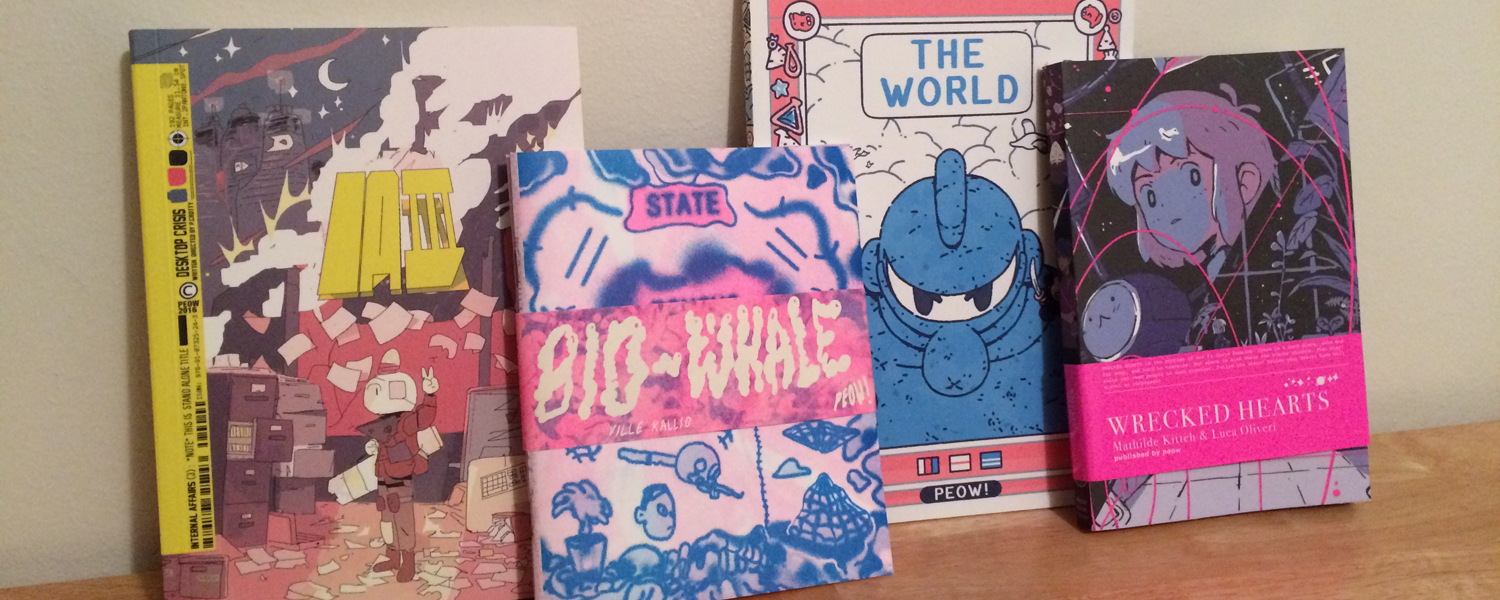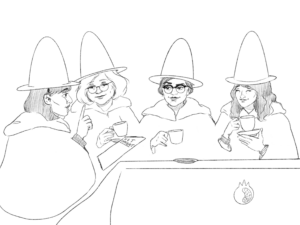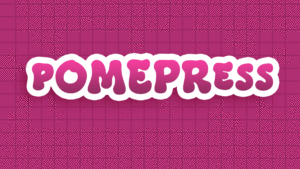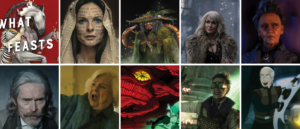Just recently, I finished reading a few titles by PEOW! Studio, a three-man print shop and art collective based in Stockholm, Sweden dedicated to printing books for some of today’s best young cartoonists. International shipping rates can be pretty expensive, so I imagine some of y’all are already starting to balk at the thought of paying them. “We have comics here” you tell me, “why pay an arm and a leg to haul more over from Sweden?”. Well, firstly because their books are very, very good. But secondly, because it appears that I and any fellow Americans are in luck, and that for a few of their newer releases they’ve lowered the price for US shipping to match their in-country rate. We should be flattered.
I’ll admit that I’m a little late to the party on PEOW!. This excellent interview by Zainab Akhtar came out all the way back in 2013 and late last year, hundreds of fans helped fund PEOW!’s Kickstarter campaign for a line of 2016 releases, shooting way past the original goal of $33,300. It’s easy to see why people are enthusiastic. PEOW!’s editorial board has excellent taste in collaborators and a firm commitment to production quality. The studio began printing on a risograph and, even after moving on to other production methods, they’ve retained an understanding of the power and value of deliberate color schemes. With one exception, the following comics are printed without any black ink, giving them a soft, vibrant look. Another unifying factor in PEOW!’s books (and one that probably doesn’t hurt their popularity) is the undeniable influence of Japanese pop culture on their artists. I would be hard-pressed to find anything that stands out as specifically Swedish in these books. Then again, that would be completely beside the point. These are deliberately international books, published in English, for an internet-savvy comics audience. Which means, since you’re already here, they’re probably for you!
The World – Valentin Seiche

In an interview in the back of this book, Seiche reminisces on “spending hours looking at Where is Waldo?” and praises the character Bomberman for symbolizing “all that [he] love[s] in Japanese designs”. A combination of those two things might be a fair description of his book. Some of The World’s two-page spreads will certainly spark recognition and delight in anyone who enjoyed searching through similar detail-packed picture books (apparently called wimmelbooks) as a kid. But whereas most such books look distinctly Western, Seiche’s round-headed characters obviously owe a lot to Japanese video games (as do the the short, funny descriptions he gives to each character in the book’s endpages).

Narratively, The World is reticent to the point of coyness. It’s first section is a wordless series of battle scenes between tanks and lil red “wizzards,” while its second half picks up 1,000 years later to check in on some newer inhabitants. Seiche gives the reader enough detail to whet the appetite but is careful to retain a sense of mystery. Whether this is fun or frustrating depends a lot on the reader’s mindset. It’s frustrating to the degree that it feels like watching the opening cutscene of a video game that you don’t actually get to play. You’re promised a world to explore but end up with only a small slice. This can also be really fun, however, because it means your imagination gets to add onto that tiny slice in any way it wishes. The experience reminds me of being younger and buying horribly incomplete sets of a manga series from Half-Price Books. Jumping into the middle of an ongoing storyline, I wouldn’t quite understand what was happening, but as I read, I enjoyed trying to piece together the fragmented narrative. It’s in this vein, I think, that The World is most enjoyable. While The World is an experiment in world-building, it also works as a meta experiment in franchise-building.
The World comes with a set of supplementary sketches and a pack of collectible stickers that feel like the promotional materials added to books to entice in new readers or else to stoke the fires of fandom among those already collecting. These extras add to the sense that this single volume of The World was meant to be part of a larger franchise, but that perhaps the series was cancelled prematurely and this book is all that remains. So, although I would enjoy if Seiche drew another volume or two or three, I think the book already works well enough by itself, as a media artifact, the unfinished nature of which being a large part of its charm. Completionists beware.
Explore more world fragments on Seiche’s tumblr.
Wrecked Hearts – Luca Oliveri & Mathilde Kitteh

Outer space romance is the flavor of the day in this shoujo manga-influenced double-feature. The two stories that make up Wrecked Hearts (The Real Thing by Luca Oliveri and Dark Energy by Mathilde Kitteh) are narratively unrelated* but their sympathetic approaches to the genre let them share a cover comfortably.
It’s clear that both Oliveri and Kitteh, for all their humor, have sincere fondnesses for shoujo tropes. Both their stories, for instance, feature protagonists who could be considered “magical girls”: The Real Thing is about a shape-shifting, hockey-playing alien named Fio and Dark Energy stars Astree, a goddess who is only stuck in human form because she’s forgotten her divine origin.
And, of course, both stories revolve around romantic pining. The Real Thing’s Fio is a middle school student who’s been having steamy boy-on-boy dreams about her classmate Roman and attempts to enact her fantasy by assuming another (male) classmate’s identity on a school trip. The unfulfilled desire in Dark Energy comes from a goofy android named Mikael who comes to Astree’s “greenhouse ship” to interview her for his blog but quickly develops a crush. And both stories climax (spoiler alert) in bursts of emotional revelation as their protagonists are forced to confront themselves and respond honestly to their respective situations.

These comics are less indebted to the shoujo tradition artwise, with both artists privileging backgrounds over the popular technique of emphatic pattern fills. Oliveri draws in a Ghibli-esque style and The Real Thing has warm naturalism thanks to his ease at capturing movement. The highlight for me, however, is Kitteh’s art which, printed in purple ink, makes use of bold dark fills to help her cute character designs pop out of the page. Wrecked Hearts blends the fantastic with the sensitive for a pair of stories which should be relatable even for those of us who have never escaped Earth’s gravity.
*The website says both stories are set in the “Wrecked Ship” universe which, sure, why not, but either story can be read and understood separately.
More from Oliveri and Kitteh can be found here and here, respectively.
Bio-Whale – Ville Kallio

If you’ve never quite understood the appeal of risograph printing, this might be the book to convince you. I’m sure Kallio’s drawings would still look fantastic in black and white, but when printed in bluescale and fluorescent pink, they take on a new liveliness, practically vibrating off the page. The combination of wonky linework, a rather eyestraining pink ink and riso-printing’s tendency to misalign creates a complex visual experience equal parts beautiful and nauseating. This is a good thing, because Bio-Whale wants to draw you in but it also wants to make you uncomfortable. Calling Bio-Whale a “sci-fi nightmare” might give you the wrong idea, in that nothing especially horrific happens and the violence isn’t very graphic. But the book’s events have a hazy, foreboding atmosphere. Okay, look, it’s trippy. There, I said it.

Bio-Whale is divided into four sections, the first three of which show a single event (the Bio-Whale being attacked with an RPG) from multiple perspectives, while the fourth serves as a (very inconclusive) conclusion. It’s unclear what the titular Bio-Whale is, though the reader is given plenty to speculate about. You know it looks like a blob with cartoon eyes, predator drone wings and an AK-47. One character describes it as a type of living “war machine” enslaved to “parasitic capitalism,” while another claims that it’s a “hyper-intelligent being with a rich emotional life”; in another segment of the book, we see it being piloted psychically by a soldier. The book has an anti-military thrust but explicit political statements (beyond the author’s self-description as a Marxist) are absent. Bio-Whale operates on a level of generalized paranoia, which isn’t to say that the fears it presents are unfounded, only that its concern is specifically focused on things that happen on the edge of awareness. Whether you share these fears or not, you have to admire Kallio’s intense vision of them.
More of Kallio’s art can be found on his tumblr.
Internal Affairs 3 – Patrick Crotty

I’ve never been an intern but I’ve always suspected that internships are pretty much bullshit, so I’m grateful to Crotty for validating that previously unfounded opinion in his new book. Internal Affairs 3 is a mostly stand-alone action/comedy about an onion-headed dude (named, conveniently, Onion) who does thankless, unpaid work for a mech company while living with his parents. I write “mostly stand-alone” because while there were previous Internal Affairs stories (sadly out-of-print now), the book does a good job of bringing the reader up to speed and there isn’t too much continuity to worry about anyway.
If anything, what the reader might need is a crash course on Crotty’s inspiration board. While I imagine that Crotty drew from his own internship experiences for the slice-of-life parts of the book, its setting and the action scenes come from a grab bag of tech-heavy sci-fi franchises, and I imagine that readers lacking some passing familiarity with Crotty’s source material might find the book hard to understand. Metal Gear Solid is probably the most important (watch for a throwaway gag referencing Big Boss near the beginning), but the integration of mecha into civilian life could bring to mind any number of anime series (Patlabor, Ghost in the Shell, etc.).
I don’t mean to suggest, however, that Crotty’s work is derivative or doesn’t offer anything other than references. While he borrows freely for narrative elements, the joy of his comic comes from his skill in playfully remixing those elements. IA3 was drawn digitally, with a “2×2 pixel pencil tool and the paint bucket,” which, while counter-intuitively low tech, grants it a sort of slacker chic. Crotty’s linework can be disconcertingly loose and sections of a character’s outline occasionally look like they’re about to drift away from each other, but it always basically works. Everything in IA3 is drawn just enough to function as part of the greater whole of the book and for every page of talking heads, there’s also a page featuring a gorgeous, dynamic action sequence.

As one of the members of PEOW!, Crotty’s comics also benefit from his experience as a printer. IA3 is printed with two colors of ink (red and blue), but it’s filled with such great use of mid- and halftones that I didn’t really miss the rest of the rainbow. It’s clear that although Crotty drafts his comics digitally, he keeps the physical end result of the book in mind. In one of my favorite sequences, Onion tosses a smoke grenade during a gunfight and the following nine pages or so are completely filled with a lush purple, barely broken by glimpses of the various combatants. It’s not the only place in the book where Crotty mixes his inks together, but it’s perhaps where the subtlety of his technique is best showcased. Internal Affairs 3 is a light-hearted romp but its author really revels in the beauty of ink on paper. I can’t imagine a better quality to have in a bookmaker.
Patrick’s art can be followed here.
All of the above books can be purchased online from the PEOW! Studio store.




